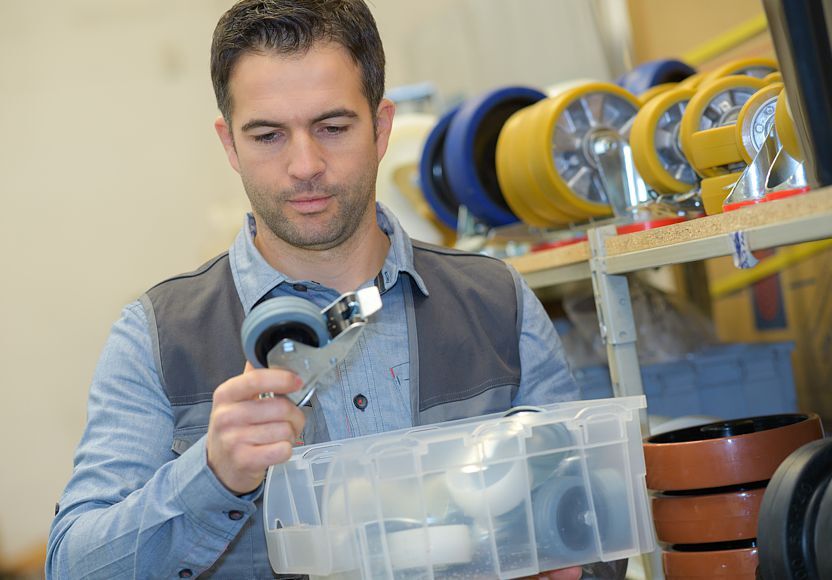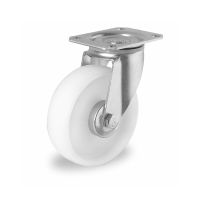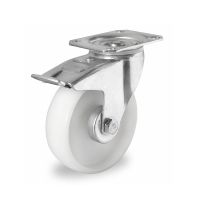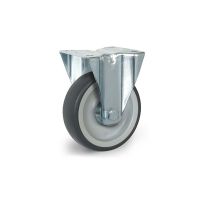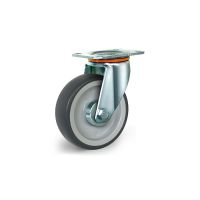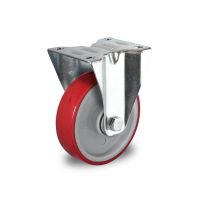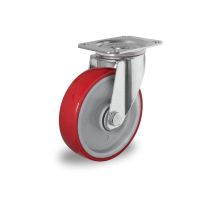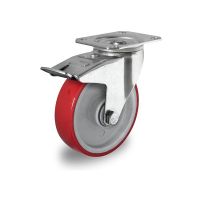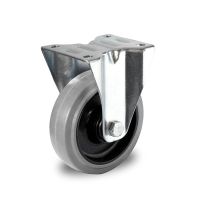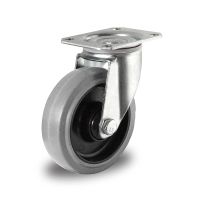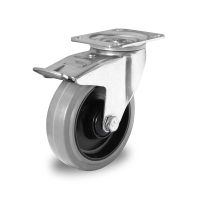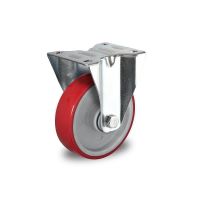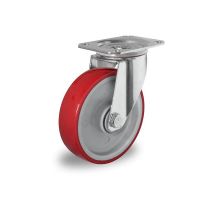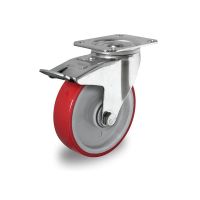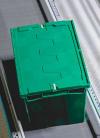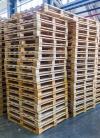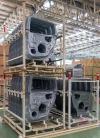When searching for answers to the question of which transport wheel to choose, we should go back in time a little to understand the essence of their origin. Although the beginnings of the use of wheels date back to the period between 3500 and 3300 BC in Asia, the oldest discovered wheel in the UK dates back to c1300 BC.
The solid wheel was part of a transport cart and is dated earlier than the medieval period, when spoke wheels were developed. With the introduction of axles, it became possible to create a relatively frictionless way of moving, which made moving loads much easier. As a result, large loads could be moved with little effort, and in addition to the fact that loads could be transported over long distances.
In heavy industrial environments such as warehouses, there are many challenges. Transport castors have to withstand the harsh conditions of daily use, with all the associated wear factors such as heavy loads, intensive work or mechanical soiling.
What to consider when choosing wheels?
The wheelsets that fit warehouse and transport trolleys come in different sizes, bearings and load capacities. It is important to choose wisely and take many aspects into account. First of all, their basic parameters such as diameter, tread type, bearing type, load capacity of the wheel are important. Other factors influencing the use of wheels include: type of ground, material used, temperature and humidity, vibration absorption.
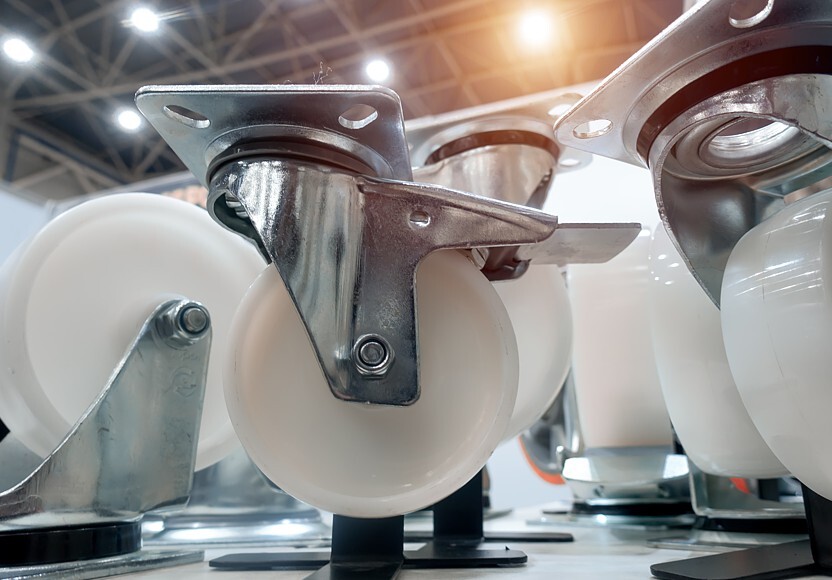
When choosing a castor, it may be important to check specific features such as noise generation, contact with harmful substances as well as electrical conductivity.
If you choose the wrong type of wheels, you may not only damage the surface on which they are used and the load being carried, but may even prevent the safe operation of the forklift - putting forklift operators at risk.
If you're looking for the right wheels for a roll container, furniture trolley or warehouse trolley, you have plenty of choice. The right wheels make a big difference to load capacity, ease of use and service life. This article gives some tips that can help you make a good decision.
1. Proper wheel load
This is the most important step when choosing whatever type of wheel you need, as it affects the safe operation of your roll cage.
The first thing you need to do is calculate the maximum potential load your roll container will have to take (don't forget to add in the dead weight of the unit itself). This is sometimes called the working load limit (WWL) or safe working load (SWL). The weight distribution must be taken into account.
p>It may be that the weight is not evenly distributed over all wheels and is too much on one side of the trolley. Consider that sometimes not all wheels will be in contact with the ground, for example when driving on an uneven surface the transport trolley may sag on 3 wheels. There may be various thresholds, corners, faults or irregularities. For off-road trolleys, rougher or less stable surfaces and debris such as lingering aggregates or puddles may also come into play.
When determining the load capacity required, the weight of the load and the trolley are added together and the result divided by a special factor K. This depends on the number of wheels and their arrangement and type.
L=(Q+N)/K [kg]
- L - wheel or castor load capacity in kg,
- N - weight of the device in kg,
- Q - weight of the transported load in kg,
- K - a ratio depending on the number of wheels on a given vehicle
In a trolley with four swivel wheels, or two swivel and two fixed wheels that are mounted on corners, it will be 3. However, when the wheels are mounted "crosswise", K will already be 2. When there are 6 wheels, K will be 4. This difference is due to the need to maintain an adequate safety margin, resulting from the risk of the total weight being distributed on fewer wheels.
Correctly choosing the correct load capacity is extremely important as it prevents possible wheel failure, damage to the load and injury to the trolley operator.
Recommended load capacity & reality
Not necessarily a wheel can carry the load given as the maximum load. This is due to the fact that in reality it may work completely differently. For example, during testing an industrial wheel is not subjected to the higher lateral forces or impacts from above that occur during the lifting and lowering of a warehouse trolley by an electric trolley. In this situation, it is necessary to choose wheels with a higher resistance to damage or to choose a lower load capacity.
Suitable wheel diameter and material to suit the road surface
When choosing wheels that will stand up to intense use, the type of surface on which the wheels will be operated is also extremely important. This includes the characteristics of the surface, e.g. whether it is flat, smooth or rough, and the material used. It is worth remembering that the more uneven the surface on which the wheel operates, the larger its diameter should be. So for example for outdoor roll containers it is better to use 125mm diameter castors than 100mm.
In order to make the best possible choice of material for the ground, it must be taken into account whether the substance from which the wheel is made offers good grip and at the same time whether it allows a free manoeuvring of the trolley with adequate cushioning if necessary.
One of the most important characteristics is the type of material the wheel tread is made of. The tread is the outer part of the wheel that comes into contact with the ground. You can choose from wheels made of thermoplastic rubber (TPR), polyurethane (PU), polypropylene (PP) or polyamide (PA). The tread material is crucial for everyday use.
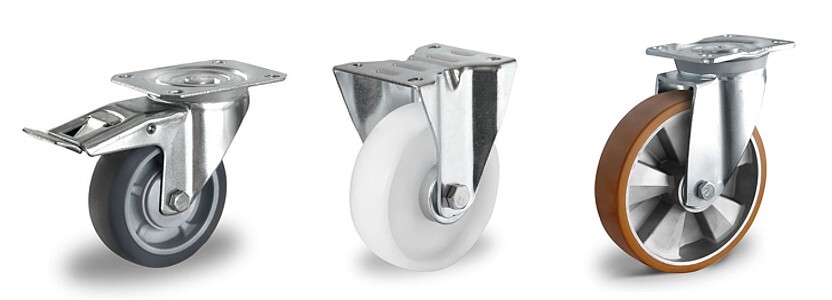
Polyamide wheels - PA or PP
Wheels with tread made of polypropylene (PP) or polyamide (PA) are often cheaper to buy and have a relatively high load capacity. They are often used under warehouse transport trolleys and roll containers. Polyamide has a wider temperature range than polypropylene. Treads made of these materials are strong, have low rolling resistance and are resistant to wear, but are not particularly sound-absorbing.
The castors used for roll container applications are most often found in the diameter range from 100mm to 125mm, while the maximum load capacity of a single castor starts at 100kg and goes up to 600kg. The polyamide castors are fitted with ball bearings.
Polyurethane wheels
This type of wheel is often chosen by customers. Polyurethane (PU) is an intermediate form of plastic and rubber and is ideal when the areas of use are very different, for example in logistics applications in city centres where indoor and outdoor applications can be mixed. Like rubber or thermoplastic rubber (TPR), polyurethane (PU) does not leave streaks and is quite sound absorbent. Thanks to the polyurethane tyre, they do not scratch or damage the floor and absorb vibrations well. The wheels are equipped with ball bearings. The maximum load capacity of the cast iron/polyurethane wheels is up to 4000kg per wheel.
Polyurethane wheels are durable and have a cushioning between the products and the ground. However, it is important to note that they are not suitable for high temperature applications as their durability will be significantly reduced (they will not withstand temperatures above 230 degrees).
Rubber wheels
Because of their softness, wheels made of rubber or are more flexible than plastic variants (PP and PA). This elasticity absorbs shocks very well and is therefore very sound-absorbing. This makes these materials ideal for use in gymnasiums, hospitals, retail or other areas where floors are more fragile and sensitive to streaky dirt. Natural rubber wheels provide better grip, better traction and a softer ride on rough terrain compared to polyurethane wheels.
3. Rolling resistance and wheelset selection
Trolling resistance is an important feature of most applications. The lower the rolling resistance, the easier it is to manoeuvre the equipment, reducing operator fatigue and increasing equipment performance.
Polyurethane wheels tend to have lower rolling resistance than rubber wheels. This is primarily due to the synthetic nature of polyurethane, which provides a more homogeneous material compared to rubber. The highly consistent material mix provides a consistent level of rolling friction.
Secondly, polyurethane wheels can be manufactured from slightly harder compounds than rubber wheels. The hardness of the material has a large impact on rolling resistance. The harder the material, the lower the rolling resistance. This is due to the tread deformation of the castor wheels. The greater the deformation (due to softer materials), the greater the effort required to roll the wheel.
4. Wheel springiness and cushioning
Amortisation and elasticity of the castor influences the comfort or smoothness of the "ride". This "smoothness" is achieved by the caster material absorbing unevenness, obstacles and floor surface irregularities.
The level of cushioning or resilience depends on the stiffness of the wheel. (i.e. how much the rubber or polyurethane wheel deforms when it runs over a bump or obstacle).
Polyurethane wheels are generally harder than rubber wheels and have a higher tear strength. Rubber wheels, on the other hand, usually provide better cushioning than polyurethane wheels.
It should be noted that in many applications, especially when working on smooth floors, the material on the wheels does not play a very important role. On the other hand, cushioning of the wheels during outdoor use is important.
5. Resistance to wear and abrasion
Rubber is made from a mixture of various ingredients, commonly known as or rubber compound. Rubber compounds usually have two main ingredients; "Raw Rubber" and "Filler", in addition to other ingredients in smaller amounts. The filler is used to increase the tensile strength of the material and a number of other property improvements. Carbon is the most common filler and gives rubber wheels their black colour.
Polyurethane, on the other hand, is a synthetic material that is created by the chemical reaction of various elements. While other additives can be mixed with polyurethane to improve properties, the composition of the material provides an exceptionally high proportion of pure polyurethane, around 95%.
The material's composition is extremely high.
Although both materials have a good level of abrasion resistance and can have a lifespan of many years, polyurethane generally has a much higher level of wear and abrasion resistance, and in controlled tests can have a lifespan 2-3 times longer than rubber wheels.
6.Protecting the ground and leaving marks
Standard rubber wheels have a black filler in their composition (as discussed above). Unfortunately, this carbon black can cause streaks on the substrate and is therefore not suitable for applications where floor marking properties are important.
However, using alternative fillers such as silica, rubber can be produced from a non-marking material. Non-marking rubber wheels are usually grey in colour and do not leave marks on the floor.
On the other hand, polyurethane generally does not leave marks on floors. The chemical composition of the polyurethane and the dye causes the colour to be fixed in the material and does not wash out and leave marks on the floor surface.
In terms of protection, both polyurethane and rubber casters provide excellent protection against floor damage due to the resilience of the material.
7. Wheel type and temperature resistance
Depending on the conditions in which the castors will be used, it may be necessary to ensure that they are resistant to external conditions - high or low temperatures, as well as higher humidity. Transport castors are used in areas with possible contact with chemicals and therefore have to be resistant to the destructive effect of such substances.
The temperature-related characteristics of industrial wheels are important as they not only influence their service life, e.g. possible accelerated wear in case of operation in freezers or near industrial ovens, but also the likelihood of accidents due to slipping or unexpected track changes.
.
If wheels are used in environments where the temperature varies greatly, it is best to choose wheels that can withstand this. The temperature range of the wheels in our range is from approximately -40°C to 80°C. Each wheel has a separate temperature indication.
8. Fixed, swivel or brake wheels?
Roll containers are usually fitted with two swivel castors and two fixed castors with a fixed direction of travel. Our wheels are fitted with a metal mounting plate and corner reinforcement as standard. The swivel wheels allow you to steer and provide excellent manoeuvrability for your trolley. This is because they can rotate a full 360 degrees and can cope with rapid changes in direction. If you opt for a 3-sided or 4-sided roll container, the swivel wheels are standard on the side where you load and unload the goods. Also for double-sided roll containers, it is best to push the mesh trolley from the side where the swivel castors are fitted. Importantly, swivel castors are manufactured with a load capacity equivalent to fixed castors, i.e. a swivel castor will have the same dynamic and rolling capacity as a fixed castor.
On the other hand, the fixed wheel is mounted on a bracket in a fixed direction. These wheels cannot be steered, but they move loads in a straight line, backwards and forwards. Most often, swivel and fixed wheels are used in combination to allow the trolley to be operated and controlled.
Beyond manoeuvrability, it is also important to be able to immobilise the wheels, and at the same time the entire trolley. Both swivel and fixed wheels can have a brake fitted to hold the equipment in the operator's chosen position. The brakes are foot-operated and can prevent dangerous situations from occurring, so that the load does not start to roll away with the trolley. It is important to use these brakes only on a flat surface. To prevent accidents, remember never to place the load on a sloping surface.
For more information on working safely with roll containers, see the article What are roll containers and why do we need them?
9. Type of wheel bearing
The specified bearing type makes it easier to move the container from a standing position. This is important, especially when loads become heavier. Bearings are the mechanical part of the wheel that allows the trolley to move and reduces friction between parts. Instead of two smooth surfaces sliding past each other, causing friction, bearings promote movement and reduce friction, reducing wear on parts over time.
There are diff rent types of bearings, but the most important are:
- Slip bearing: these are generally straight tubes on which the wheel axle rotates, ideal for lower loads or where there are high temperatures or damp environments
- Cylindrical roller bearings: made to withstand high impact, reduce rolling resistance and can be used in heavy duty applications
- Ball bearings: the most common type and are used where they can get hot and cause friction.
If wheels are used frequently and intensively, ball bearing wheels are best. They are generally more durable, have less rolling resistance and a longer life than wheels fitted with a plain or roller bearing.
Tailored castors to suit the type of application
Although castors have been used primarily for industrial purposes for many years, there is now a wide range of castors, each with its own unique characteristics, suitable for many applications - this includes braked castors, directional lock castors, castors made of materials with varying degrees of resilience, rolling capacity and hardness.


